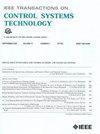Practical Implementation of a Reset Controller to Improve Performance of an Industrial Motion Stage
IF 4.9
2区 计算机科学
Q1 AUTOMATION & CONTROL SYSTEMS
引用次数: 0
Abstract
In this work, the proportional Clegg integrator (PCI), a resetting proportional-integrator (PI) element, is studied with the aim of improving the performance of an industrial motion stage currently controlled by a linear controller. A novel parallel continuous reset (CR) architecture, based on the PI, is presented, along with frequency-based tuning guidelines, similar to linear time-invariant (LTI) loopshaping techniques. Open-loop higher order sinusoidal input describing functions (HOSIDFs) and pseudo-sensitivities computed through analytically derived approximate closed-loop HOSIDFs were effectively applied to predict steady-state performance. The experimental results, obtained on a wire bonding machine, confirmed that resonance-induced vibrations of the machine’s base frame can be suppressed more effectively by adopting a PCI-PID controller compared to the currently used linear controller. The novel structure does not only reduce unwanted excitation of higher order harmonics of the base frame resonance, such as the series CR architecture recently introduced in literature, but also avoids amplification of noise when implemented in practice. With the novel parallel structure, a significant (32%) decrease in the root mean square (rms) of the settling error could be achieved when compared to the linear controller currently used and the series CR reset structure.提高工业运动平台性能的复位控制器的实际应用
本研究对克莱格比例积分器(PCI)进行了研究,它是一种复位比例积分器(PI)元件,旨在改善目前由线性控制器控制的工业运动平台的性能。在 PI 的基础上,提出了一种新颖的并行连续复位 (CR) 架构,以及基于频率的调谐指南,类似于线性时不变 (LTI) 环路整形技术。开环高阶正弦输入描述函数(HOSIDF)和通过分析得出的近似闭环 HOSIDF 计算出的伪灵敏度被有效地应用于预测稳态性能。在一台焊线机上获得的实验结果证实,与目前使用的线性控制器相比,采用 PCI-PID 控制器能更有效地抑制机器底座的共振引起的振动。这种新型结构不仅减少了对基架共振高阶谐波的不必要激励,如最近在文献中介绍的串联 CR 结构,而且在实际应用中还避免了噪声的放大。与目前使用的线性控制器和串联 CR 复位结构相比,新型并联结构的均方根(rms)沉降误差显著降低了 32%。
本文章由计算机程序翻译,如有差异,请以英文原文为准。
求助全文
约1分钟内获得全文
求助全文
来源期刊

IEEE Transactions on Control Systems Technology
工程技术-工程:电子与电气
CiteScore
10.70
自引率
2.10%
发文量
218
审稿时长
6.7 months
期刊介绍:
The IEEE Transactions on Control Systems Technology publishes high quality technical papers on technological advances in control engineering. The word technology is from the Greek technologia. The modern meaning is a scientific method to achieve a practical purpose. Control Systems Technology includes all aspects of control engineering needed to implement practical control systems, from analysis and design, through simulation and hardware. A primary purpose of the IEEE Transactions on Control Systems Technology is to have an archival publication which will bridge the gap between theory and practice. Papers are published in the IEEE Transactions on Control System Technology which disclose significant new knowledge, exploratory developments, or practical applications in all aspects of technology needed to implement control systems, from analysis and design through simulation, and hardware.
 求助内容:
求助内容: 应助结果提醒方式:
应助结果提醒方式:


